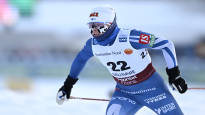Hanna Salminen, communications director of the Respiratory Association, says that in the cold it is easy to breathe through the mouth, which allows cold air to enter the lungs.
The mercury is falling, but I would like to do sports outside. However, moving around in the freezing cold has its risks.
For example, during the opening weekend of the cross-country skiing World Cup season in Ruka, the skiing stars froze their genitals and hands in 15–18 degrees below zero.
In addition to frostbite, the cold affects breathing. Communications Director of the Breathing Association Hanna Salminen says that when it’s cold, the mucous membranes of many noses become irritated and swollen, so it’s easy to start breathing through the mouth.
– When a person breathes through the mouth and in freezing weather, the air goes directly to the lungs. At 20 degrees below zero, the air reaching the lungs is approximately ten degrees colder than when breathing air at room temperature, i.e. really cold air enters the lungs.
Cold air entering the lungs can damage mucous membranes or cause a sudden cough.
Cold increases symptoms in the majority of people with asthma. People with allergies, bronchitis or emphysema are also sensitive to cold symptoms.
The effect of frost is being studied
Asthma has been diagnosed in cross-country skiers clearly more than the rest of the population. In the Skiing World Cup and in the competitions organized by the Finnish Ski Association, the freezing point is -20. In Finland, the limit is -15 for distances over 20 kilometers and in competitions for under-16s. The frost limit for veterans’ SM skiing is -17.
The responsible physician of the Olympic Committee Maarit Valtonen says that there is still no really researched information about the frost limits of cross-country skiing. At the end of the year, in connection with the Vuokatti Skandinavia Cup, data collection was carried out, where cross-country skiers swallowed a thermometer capsule during training and the competition.
In hot conditions, similar research has been done, for example, at the World Athletics Championships in Doha and the Olympic Games in Tokyo.
– We are now cooperating with the same research group. Funded by the International Olympic Committee, we study the effect of freezing temperatures on core temperature and performance. We want to get to more researched information, Valtonen says.
– At the moment, the frost limits are determined by feeling the weather. Of course, there must be some limit, but yes, -20 or -17 is really cold for an athlete.
Cold tolerance is individual
Hanna Salminen advises to protect the lungs from frost with, for example, breathing air heaters and neckerchiefs.
– When you use these heaters around the face and neck, it increases the resistance to the air flow, meaning that breathing becomes heavier than normal.
A cold does not prevent exercise, but especially those suffering from respiratory diseases should halve the exercise level by slowing down, for example.
– If you have a respiratory illness, always carry bronchodilator medicines with you when you are out in the cold.
According to Salminen, respiratory symptoms, such as shortness of breath, typically occur when it is minus 15–25 degrees. The wind can affect the bite of the frost.
Body size and shape, the amount of subcutaneous fat, fitness, age, gender and smoking affect how well everyone tolerates the cold. In smokers, respiratory symptoms in the cold are twice as common as in non-smokers.
Update 4/1/2024 at 9:14: Changed the main picture of the story.
